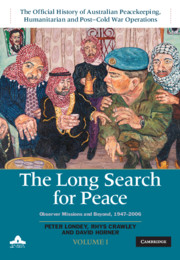Book contents
- The Long Search for Peace
- The Official History of Australian Peacekeeping, Humanitarian and Post–Cold War Operations
- The Long Search for Peace
- Copyright page
- Contents
- Maps
- Preface
- Glossary
- Part 1 Actor and observer
- 1 The origins of peacekeeping
- 2 St George and the maiden
- 3 Inventing peacekeeping
- 4 Failure
- 5 Success
- 6 Observing at a critical moment
- 7 An intractable dispute
- 8 ‘Tough men wanted’
- 9 Australia and the problem of Palestine
- 10 The Six Day War and after
- 11 ‘If you’re not confused, you don’t understand the situation’
- 12 Over jungle and swamp
- 13 A reluctant start
- 14 The first decade
- 15 Australia and the invention of peacekeeping
- Part 2 New ambitions
- Part 3 Carrying on
- Conclusion
- Book part
- Bibliography
- Index
- Plate Section (PDF Only)
1 - The origins of peacekeeping
Australia responds to the post-war world
from Part 1 - Actor and observer
Published online by Cambridge University Press: 27 September 2019
- The Long Search for Peace
- The Official History of Australian Peacekeeping, Humanitarian and Post–Cold War Operations
- The Long Search for Peace
- Copyright page
- Contents
- Maps
- Preface
- Glossary
- Part 1 Actor and observer
- 1 The origins of peacekeeping
- 2 St George and the maiden
- 3 Inventing peacekeeping
- 4 Failure
- 5 Success
- 6 Observing at a critical moment
- 7 An intractable dispute
- 8 ‘Tough men wanted’
- 9 Australia and the problem of Palestine
- 10 The Six Day War and after
- 11 ‘If you’re not confused, you don’t understand the situation’
- 12 Over jungle and swamp
- 13 A reluctant start
- 14 The first decade
- 15 Australia and the invention of peacekeeping
- Part 2 New ambitions
- Part 3 Carrying on
- Conclusion
- Book part
- Bibliography
- Index
- Plate Section (PDF Only)
Summary
War, sadly, has always been part of human affairs, however much poets and ordinary people from antiquity onwards have longed for the blessings of peace. From earliest times states have allied with each other, promising not to make war on each other and, often, to defend the other from attack. The subject of this volume, however, is not peace but peacekeeping: the use of members of armed forces (as well as police and other civilians), working in a multinational environment in the wake of conflict, helping bring about conditions that will allow the parties to the conflict to build a more peaceable future. The cardinal qualities of peacekeepers, as against those engaged in fighting wars, are that they should use the minimum level of violence necessary to achieve their goals and that at some level they should be impartial in the disputes between the parties. Importantly, they are representatives of the international community, not of their own country’s government and their own national interests. That is why peacekeeping is conducted by multinational forces, and unilateral efforts by one state to conduct ‘peacekeeping’ are liable to be regarded with suspicion.
- Type
- Chapter
- Information
- The Long Search for PeaceObserver Missions and Beyond, 1947–2006, pp. 3 - 30Publisher: Cambridge University PressPrint publication year: 2019



